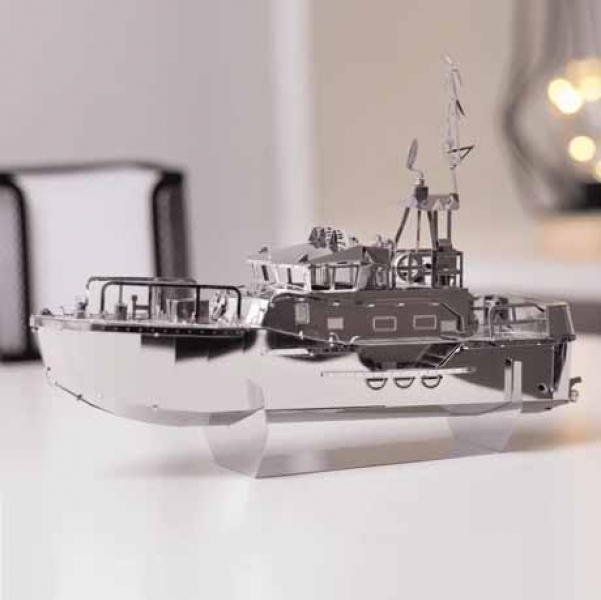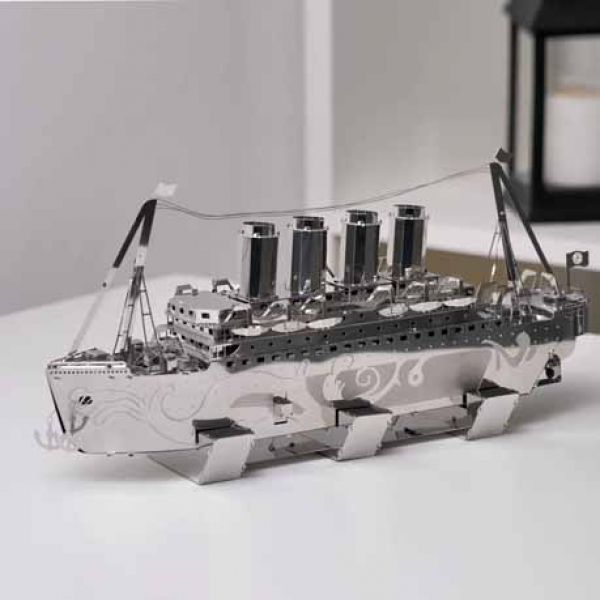Metal Time Ships

Ship Guardian of the Coasts Metal Time Kit
Ship Guardian of the Coasts Metal Time Kit A coastguard is an organisation responsible for maritime security in a particular country. Among the duties that may be entrusted to a Coast Guard are: Search and rescue, enforcement of maritime law, security of vessels, maintenance of navigation marks and border control. History of the model The old CG-47305 was cruising through the turquoise waters of Bodega Bay to conduct another patrol of the Marine Protected Areas when the radar detected an object moving at high speed. Of course, it could be San Francisco's "golden" youth going all out in a speedboat, or it could be poachers. And the team decided to check out the vessel, because that is the Coast Guard's job. The patrol's engine howled and quickly picked up speed. Despite its age, it could still keep up with glamorous motorboats. Besides, the crew knew these waters like the back of their hands. The chase was short and ended unexpectedly: automatic fire was heard from the side of the boat. The bullets did not even scratch the armoured side of the patrol boat, but it became clear to everyone: the case was taking a criminal turn. The crew commander notified the police and decided to continue the pursuit. The patrol boat pushed the intruders' boat closer and closer to the shore. The criminals tried to hide, but there is no place for it in the sea. Then, when a police helicopter appeared in the sky and two ranger boats from the nature reserve approached from the coast, the fugitives had to cut their engines. So CG-47305 seized a large load of drugs. And the Coast Guard command decided to technically retrofit more than 100 boats, which have a lifespan of almost 25 years. The US Coast Guard has many missions: It patrols off the coast, rescues people in distress, prevents crime and illegal fishing, protects closed areas and state borders. The patrol fleet is diverse: from small boats to frigates, and each has its own task. Metal Time's engineers chose a standard 47-foot (14.3 m) boat, most commonly used in the coastal waters of the United States, to design the Guardian of the Coasts. These vessels were produced in the early 90s of the XX century, and in 2017 it was decided to modernise their fleet and extend their service life by another 20 years. So the Guardian of the Coasts model is based on a real prototype. It has been designed with great attention to detail. The deckhouse with an overview of the controls, radio antennas, stairs, handrails and other structural elements of the boat are faithfully reproduced. As always, "Metal time" presents an original and beautiful finished model of the "Guardian of the Coasts" that will win the hearts of all who are not indifferent to seafaring. Features, advantages The Guardian of the Coasts is powered by an electric motor that drives the ship's radar. The hull is supported by the demonstration platform. Thanks to it, the model can be placed on any horizontal surface as an interior decoration, as an exhibit of a collection or as an element of an installation. The assembly of this model is a challenge for lovers of manual work and serves as an excellent development of metalworking skills and technical creativity. Like all of Metal Time's models, Guardian of the Coasts is made of sustainable, food-grade stainless steel that is approved for consumer products and toys. The precise cutting of the set eliminates the possibility of cuts during assembly. The parts fit together precisely and cause no problems during assembly. Pleasant feel, durability and the aesthetics of the matt metal distinguish the steel parts from the wooden or plastic parts used in other constructions. The practical flat packaging made of sustainable, recyclable cardboard combines compactness and the aesthetics of a status gift. Every buyer of the "Metal Time" model receives a club badge, a thank-you card and a unique number assigned to each model. Joining the Metal Time Club opens up additional opportunities for every customer. Specifications Quantity of parts, piece: 161 Difficulty, from 1 to 8: 5 Hours for assembly (average): 10 Model size (cm): 21 x 6 x 12 Model size (inches): 8.26 x 2.36 x 4.72 Size of packaging: L Rotating ship radar Display stand Clear display Batteries Power

Lost at the Sea Ocean Ship Metal Time Kit Titanic
Lost at the Sea Ocean Ship Metal Time Kit The launching of Titanic took place on 31 May 1911 at 12:15 pm in the presence of Lord Pirrie, J. Pierpont Morgan, J. Bruce Ismay and 100,000 onlookers. History of the Titanic On a calm, moonless night on 15 April 1912, the most famous maritime disaster in history occurred 600 kilometres from Newfoundland. The most innovative ship ever designed by a human engineering genius collided with an iceberg and sank, killing 1,517 passengers and crew. The "Olympic" class ship was named "Titanic" and became a symbol of the superiority of the forces of nature over the human mind. Regardless of the terrible accident that triggered the disaster, the Titanic is to be admired as the most perfect creation of shipbuilders at the beginning of the 20th century. At the time of her launch, she was the largest passenger steamer. Her length was 269 metres, roughly the area of three football pitches, while her breadth was 28 metres. The height from the keel to the top of the mast was 56 metres, which is about the height of a modern 20-storey building. The mass of the steamer was 52310 tonnes. This is equivalent to almost 300 Boeing 747 aircraft. Titanic had the most advanced technology. Two steam engines and a turbine provided an output of 55,000 litres per second. A pair of three-bladed side and four-bladed centre propellers gave the ship an acceleration of 42 km/h. The entire ship was electrified. Electric bulkheads were installed between the holds, which closed when water was detected. Modern communication systems gave the captain and the officer on duty the ability to monitor all the ship's systems. When selecting ship models for a designer to create, the "Metal Time" engineers first looked to the history of the most impeccable ships of the early 20th century and named the model "Lost at Sea". In this model, the characteristics of the super steamers of this era can be found: splendour, power and grace. Two propellers, four pipes, four decks, anchors with chains and holds with gearbox and electric motor - this ship will delight anyone interested in technical masterpieces. The numerous components and parts of the model will give you many priceless hours of pleasure in technical creativity. The taming of the metal and the perfection of the result achieved will leave a remarkable impression and give a sense of belonging to the significant creations of the past. The Lost at Sea is a tribute to the audacity of the inventor and the courage of the crews of the great steamships of the 20th century. Century. Therefore, the Lost at Sea model should definitely be added to your collection. Features, advantages The Lost at Sea model is one of Metal Time's largest models. This is confirmed by the oversize of the super steamer that turned out to be its model. Therefore, the number of parts and elements of this model is many times higher than the simpler ready-made models. This guarantees an exciting immersion into the theory and practice of shipbuilding at the time of the steam engine. The model is equipped with an electric motor with gearbox that drives the ship's propellers instead of a steam engine. The hull of the ship forms the back of the demonstration platform. Curved cuts are made on the sides to imitate waves. Through cut-outs on the sides, one can observe how the mechanisms work. The prefabricated model "Lost at Sea" will decorate the interior of the home of the lover of adventure novels and the wind-salted "Sea Wolf". The legendary super liner will reflect the unprecedented love story of a romantic schoolgirl and symbolise luxury and innovation on the desk of a businessman. The precise cutting of the set eliminates the risk of cuts during assembly. The parts fit exactly into each other and do not lead to joint problems. The pleasant feel, durability and aesthetics of the brushed metal constructively differentiates steel parts from plastic or wooden parts used by other designers. The matching flat packaging made of durable, environmentally friendly cardboard integrates the solidity and aesthetics of a status gift. Every buyer of a Metal Time model receives a club badge, a thank-you card and a special number for each model. Joining the Metal Time Club opens up further opportunities for each customer. Description: Quantity of parts, piece: 158 Level of difficulty, from 1 to 8: 4 Hours for assembly (average): 10 Model size (cm): 30 x 6 x 14 Model size (inches): 11.81 x 2.36 x 5.51 Size of packaging: L View of rotating gears Realistic pipes Movable propellers Four decks
